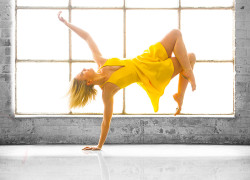
The industrial precinct of Kensington is an unexpected place to find an engrossing cultural experience but that’s where you’ll find Motion Gallery, performed at Transit Dance’s contemporary dance training studio in an enormous wool-store, built in 1891.
Once inside, the audience is encouraged to enjoy drinks and canapés in the foyer before being guided around the six dance ‘exhibits’, presented by the facility’s second year students and directed by Paul Malek. The three to six minute pieces have contrasting, abstract themes such as proxemics, perception and mental illness, but with a consistent eerie and intense tone that binds them together. The high ceilings, brick walls and exposed beams of the facility add to the atmosphere. There is an enjoyable sense of exploration as the audience is led through the visually striking spaces.
While the audience is seated for two pieces, during the other four they have the option to move around to view the dancers from different angles. Observing each duo or solo piece at very close range is powerful, especially as the dancers play with piercing eye contact and the invasion of personal space. Audience members are at times led by the hand, brushed on the shoulder or confronted with a dancer moving uncomfortably close to them.
The students’ choreography is strong, moody and exploratory, executed with technical proficiency. One of the most powerful sections is in the final piece, choreographed by Stephanie Newton, which effectively evokes the feeling of being tortured in one’s own mind when suffering from mental illness through frenzied, erratic movement, hyperventilation and a strong sense of one performer’s desire to escape the space.
Most of the pieces incorporate prerecorded footage of the dancers projected onto the walls. While this is effective use of the space, with so many choices of focus the movement on the walls is an unnecessary distraction from the immersive experience. The exception is the piece by Lydia Mcglinchey which uses projections of textures and simple images rather than dancers.
The soundtrack is used as an unobtrusive element supporting the dance, rather than being a feature in itself. Recorded speech and sounds evocative of nature, the human body and animals reinforce the theme of each piece.
The performance is not completely immersive given the presence of a large number of guides, who unfortunately detract from the performance at times. Their casual attitude as external observers is jarring. There are also some OH&S issues with tripping hazards in the darkened rooms that were not managed well.
Apart from these minor issues, Motion Gallery offers an enthralling experience in a spectacular setting.
Motion Gallery played at 10 Elizabeth Street Kensington from 17-19 September.

